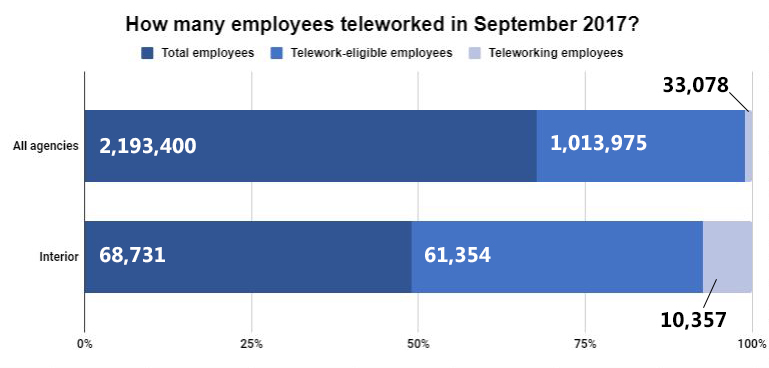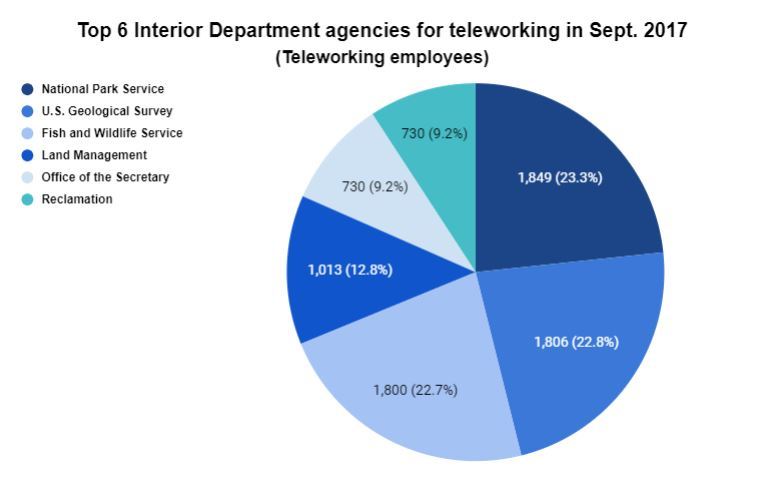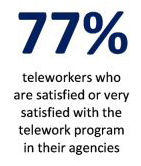
Exclusive
Interior planning changes to its telework program for employees, supervisors
The Interior Department is the latest agency to make changes to its telework program within the past year.
Best listening experience is on Chrome, Firefox or Safari. Subscribe to Federal Drive’s daily audio interviews on Apple Podcasts or PodcastOne.
As several agencies have or are considering updates to years-old telework policies in recent months, the Interior Department is the latest agency to indicate its program needs an update.
Employees previously eligible for regular telework will be required to come to their official work sites two full days every biweekly pay period, according to the department’s new policy, which Federal News Network reviewed.
In addition, Interior supervisors can no longer telework on a regular basis but may be eligible for situational arrangements, according to the policy distributed to department managers this month.
“Given the value and importance of their interpersonal interactions with staff, supervisory positions are not suitable for core telework,” the department wrote in a June management update describing the new policy.
Higher-level management officials must review and approve any reoccurring and scheduled telework agreements. Managers must review these agreements every year to ensure they’re still effective and in the agency’s best interests. Interior will launch an automated telework agreement form, which will help the department better manage and track employee use of the program.
Related Stories

Secretary’s ‘OneUSDA’ vision rings hollow to some in light of new telework policy
The new policy will go into effect July 15, the department said. The policy document said the July 15 date gave bureau and office leadership enough time to communicate the changes to employees and determine whether additional guidance is necessary.
“The most important asset at the department is its people, and it’s critical to provide a work environment that best positions them to best serve the public,” an Interior spokeswoman said in a statement to Federal News Network. “The department is continually evaluating and implementing measures to improve its operations to provide the highest level of customer service to the American people, while also facilitating a work environment that attracts the best and brightest to serve in the public sector. To accomplish these goals, the telework policy needed to be modernized to reflect best practices as it was last adopted in 2012.”
Interior’s existing policy, which dates back to 2012, describes telework as an innovative management tool that allows employees to balance their home and work lives. The department allowed eligible employees to set their own agreements with supervisors, and the 2012 policy doesn’t mention an explicit expectation that the workforce spend a certain number of days in the office or at their work sites.
Though it’s not an entitlement, Interior said in 2012 it encouraged a “robust telework program.”
“Employees who telework are often more productive and generate better quality work due to the quiet environment where interruptions are minimized,” the 2012 policy reads. “Supervisors report improved employee loyalty and commitment from teleworkers. Supervisors often report an increase in quality of work and cooperation from the teleworker in ensuring that office coverage is maintained.”
A significant portion — roughly 89% — of Interior’s workforce of 68,731 employees were eligible to telework in fiscal 2017, according to the Office of Personnel Management’s most recent report on governmentwide telework use.
But because Interior is making changes to the way it tracks employee telework use, little other data that describes how often its workforce actually uses the program is publicly available. According to the OPM report, about 15% of the workforce teleworked at some point in September 2017.

Overall telework eligibility and participation at Interior varies widely depending on the bureau and component.

Telework participation dipped slightly in 2017, according to the latest OPM data.
The change in policy from the Interior Department comes shortly after OPM urged agencies to consider using workplace flexibilities and make better use of telework during a three-month closure of six stations along the Washington, D.C., Metrorail system this summer.
Like agencies’ existing telework programs, guidance from individual organizations during the summer metro construction work has been a mixed bag. Some agencies, such as the Nuclear Regulatory Commission, encouraged supervisors to actively set alternative work schedules and allow more telework for employees impacted by the metro closures. Others have been more vague.
When asked about Interior’s handling of the summer Metro closures and its impact on employees, the department reiterated that situational telework is available.
A shift in attitudes toward telework?
Interior’s new policy, though not as restrictive as the limits other agencies have implemented in recent months and years, is another in a series of telework updates from a variety of organizations.
Both the departments of Agriculture and Education last year limited telework to one day a week for their employees. The Department of Health and Human Services’ Office of the Assistant Secretary for Health (OASH) implemented a similar one-day limit on its employees starting last month.
For Education and HHS, changes in the agencies’ telework policies came after often contentious negotiations with their employee unions.
Education, after months of negotiations with the American Federation of Government Employees, implemented a new set of bargaining articles the union didn’t agree to. The new document eliminated telework from the list of topics AFGE could bargain over.
HHS, after the Federal Service Impasses Panel (FSIP) weighed in on the agency’s disputes with the National Treasury Employees Union and rewrote portions of the parties’ bargaining contract, notified NTEU it would implement a new policy for OASH employees.
“I don’t think it was ever a popular strategy for people in leadership jobs; even the ones who I think made a good-faith effort to warm up to it and utilize it often spoke of the challenges for them trying make it available,” said Reginald Wells, a former chief human capital officer for the Social Security Administration. “I’ve talked to a few who were totally sold on it and thought it was the best thing since sliced bread for them and their employees.”
Wells is now a senior lecturer at American University’s School of Public Affairs.
As an executive managing teleworkers at SSA, Wells said he and his colleagues prioritized an employee’s productivity first and the overall benefits that such an agreement brought to the workers second.
Latest Workforce News
“When that supervisor … goes to deal with the crisis, very often they’re going to grab the people who are physically there, because they want to be immersed in it,” Wells said. “They don’t want to have to rely necessarily on technology to bring everybody together, and so they go with the people there.”
Other employees who telework on a regular basis may feel like their coworkers are getting more face time — and potentially more opportunities — from their supervisors. In many ways, they are, Wells said.
“Sometimes employees [would] just drop by the office to say hello but in doing that [would] get a little face time with the CHCO and perhaps share some things that I might not have known otherwise,” he said. “For me, I found that was more beneficial for me to be physically in my office space than not.”
SSA today may be considering its own telework policy updates. The FSIP, after SSA and AFGE disagreed over changes the department wanted to make to its telework program, allowed management to determine whether previously-eligible employees should be allowed to continue using it.
The panel’s decision references examples from six SSA managers who cited customer service and operational challenges due to telework.
One program manager who handled SSA IT operations said issues arose at 12 field offices after the agency implemented a telework policy in 2012.
Three SSA field office managers noted increased customer wait times “due to a lack of in-person employee availability,” the FSIP decision said.
“At least 18 hearing offices had to reduce the number of days of telework per week because in-person duties were not being accomplished,” the impasses panel continued. “A chief administrative law judge stated that his office saw an increase in the number of in-person employees available to address such duties once his office decreased the number of telework days.”

If agencies do make unexpected changes to their telework policies, Wells said leadership should be prepared to handle the potential fallout with their employees. High-performing organizations offer top talent various workplace flexibilities as an incentive to choose an agency over another employee.
Employees across government have rated their experiences with telework favorably. About 83% of eligible teleworkers said it improved their morale, while 77% said telework played a role in better managing stress, according to the results of OPM’s most recent work-life survey.
Two dozen agencies told OPM they mentioned telework in their job postings and interviews with potential candidates, and many organizations emphasized the program in their recruitment materials.
“It is difficult when you’re taking some of it back or you’re changing your policy,” Wells said. “It feels like a bait-and-switch. You’ve hired me five years ago, and I enjoy the telework arrangement that we’ve established. I’m doing my work. Maybe I’m even producing at a higher level than I would if I had to physically come in every day. But now you’re taking it away from me. It looks like you lured me into it only to renege.”
Copyright © 2024 Federal News Network. All rights reserved. This website is not intended for users located within the European Economic Area.
Nicole Ogrysko is a reporter for Federal News Network focusing on the federal workforce and federal pay and benefits.
Follow @nogryskoWFED








